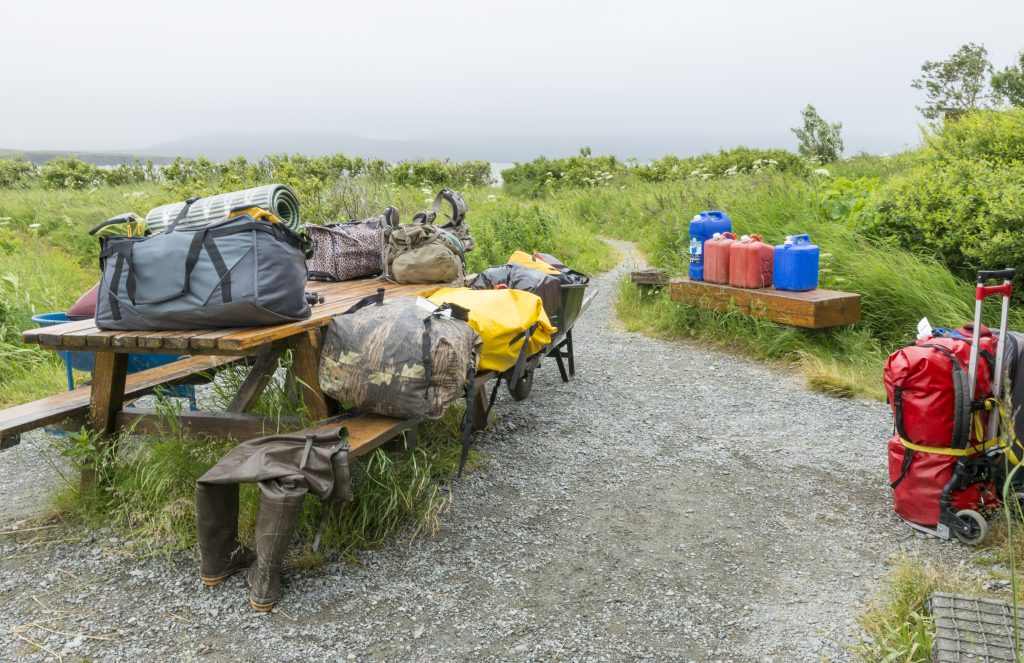The falls along McNeil River are considered some of the best bear viewing in the world. Photo by Dawn K. Wilson.
I opened the email from the Alaska Department of Fish and Game and read the words: “Congratulations! You have secured a permit to visit the McNeil River State Game Sanctuary and Refuge.” McNeil River State Game Sanctuary is considered by many—me included—to be one of the best bear-viewing opportunities in the world. Because of its popularity, a lottery exists to create a fair and equitable system for selecting who gets a permit to visit.
In the last five years, only two to three percent of those who applied received a permit for the first few weeks in July, the month with the highest concentration of bears. It had taken me three years. I was thrilled.
I carefully read the details about what to bring, how I would live, and what precautions to take for visiting this small camp on the east side of the Alaska Peninsula. The first thing that caught my eye: “You must bring all the food you need for your five-day, four-night stay. This is a wilderness experience, and food is not provided.”
In addition to my food, I also needed to bring my own plate, bowl, cup, and utensils, as well as a filtration system to make the creek water we used behind the cook cabin potable for drinking. Pots, pans, and a propane camp stove would be provided.
I would only be at McNeil River long enough to eat about 12 meals plus snacks. Weather is always a factor in this coastal region, so I added additional meals in case my return flight was delayed. It sounded easy enough. But a challenge arose when I realized I would need hearty meals to keep me warm and full of energy for the daily one-to-four-mile hikes to Mikfik Creek and McNeil Falls, yet I had no fridge or freezer to store food and no microwave or oven to cook meals. I also had to limit my baggage weight for the one-hour flight to McNeil to what I could carry, including clothing, camera gear, and camping equipment. I opted for items that could be mixed with hot water, focused on high-calorie selections, and ditched the packaging in favor of small Ziploc bags for easier storage and less weight. Any packaging you bring that can’t be burned must be taken back with you on the plane.
The first consideration—drinks—was easy. A packet of hot chocolate mix added to hot water made a great drink at the end of a cold day in the elements of damp McNeil River State Game Sanctuary. Throw in a handful of marshmallows for an extra special treat.
Tea bags provided another light yet warm alternative to plain water. For coffee drinkers, Starbucks and other coffee companies sell single-serve packets. Just count out the number of cups you want, put the packets into a baggie, and leave the rest of the packaging at home. Iced tea mix also works great, as well as powdered Tang, which provides a kick of vitamin C and calcium.

Next up: breakfast. I went with a homemade coconut oatmeal recipe with raisins, cranberries, coconut, and walnuts—light and easy to make by just adding hot water. I premixed enough ingredients at home for my four morning meals, plus one just in case, and put each day into an individual snack-size Ziploc bag.
Dinner options were abundant. The most straight-forward choice was to bring five freeze-dried meals. These camping staples have come a long way from when they were first introduced in the 1950s. Today you can select from a wide variety of palatable meal options, such as chicken teriyaki, mushroom risotto, biscuits and gravy, and mac and cheese.
Planning a lunch menu presented the greatest challenge. Each day is spent in the field, and you need to bring all your snacks and lunches with you—without a stove for heating up food. Salami and sausage at World Market, along with individual, shelf-stable cheeses, made for a delicious, protein-rich, and convenient meal.
Finally: snacks. Bring a variety that work for you. I liked having chocolate in a form that didn’t melt or break—like M&Ms—and freeze-dried fruit. High-energy bars, like Clif Bar, also make sensible options to maintain your strength while in the field.
By the end of the four-day trip, I had captured more than 5,500 photos of not just bears but red fox, yellow warblers, bald eagles, and a meadow jumping mouse. My bags were a lot lighter on the return trip since I consumed most of my food, but the experience filled my heart with happiness and gratitude for a very memorable trip.


Comments are closed.